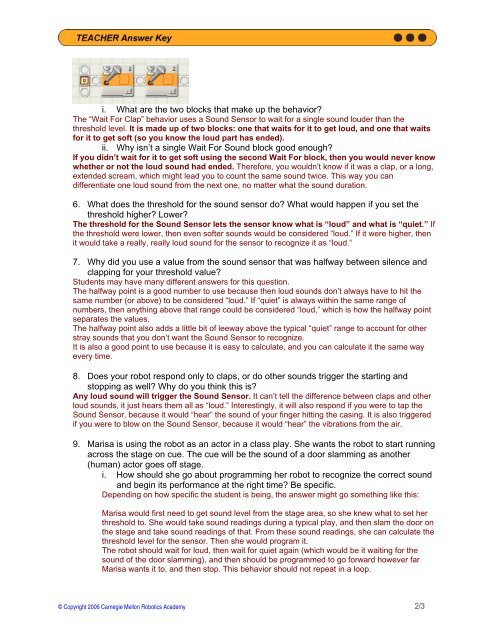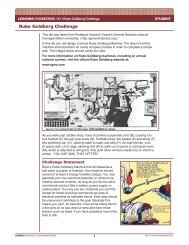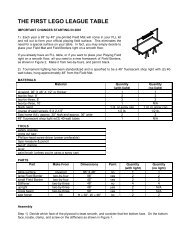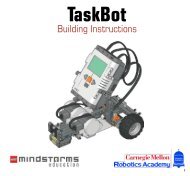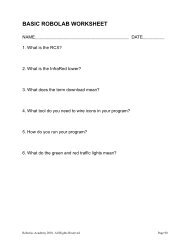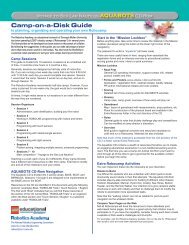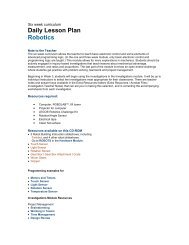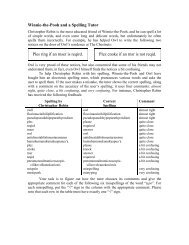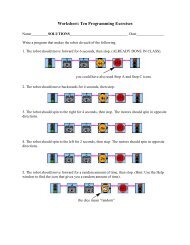Teacher Answer Key: Clap On, Clap Off - Robotics Academy
Teacher Answer Key: Clap On, Clap Off - Robotics Academy
Teacher Answer Key: Clap On, Clap Off - Robotics Academy
Create successful ePaper yourself
Turn your PDF publications into a flip-book with our unique Google optimized e-Paper software.
i. What are the two blocks that make up the behavior?<br />
The “Wait For <strong>Clap</strong>” behavior uses a Sound Sensor to wait for a single sound louder than the<br />
threshold level. It is made up of two blocks: one that waits for it to get loud, and one that waits<br />
for it to get soft (so you know the loud part has ended).<br />
ii. Why isn’t a single Wait For Sound block good enough?<br />
If you didn’t wait for it to get soft using the second Wait For block, then you would never know<br />
whether or not the loud sound had ended. Therefore, you wouldn’t know if it was a clap, or a long,<br />
extended scream, which might lead you to count the same sound twice. This way you can<br />
differentiate one loud sound from the next one, no matter what the sound duration.<br />
6. What does the threshold for the sound sensor do? What would happen if you set the<br />
threshold higher? Lower?<br />
The threshold for the Sound Sensor lets the sensor know what is “loud” and what is “quiet.” If<br />
the threshold were lower, then even softer sounds would be considered “loud.” If it were higher, then<br />
it would take a really, really loud sound for the sensor to recognize it as “loud.”<br />
7. Why did you use a value from the sound sensor that was halfway between silence and<br />
clapping for your threshold value?<br />
Students may have many different answers for this question.<br />
The halfway point is a good number to use because then loud sounds don’t always have to hit the<br />
same number (or above) to be considered “loud.” If “quiet” is always within the same range of<br />
numbers, then anything above that range could be considered “loud,” which is how the halfway point<br />
separates the values.<br />
The halfway point also adds a little bit of leeway above the typical “quiet” range to account for other<br />
stray sounds that you don’t want the Sound Sensor to recognize.<br />
It is also a good point to use because it is easy to calculate, and you can calculate it the same way<br />
every time.<br />
8. Does your robot respond only to claps, or do other sounds trigger the starting and<br />
stopping as well? Why do you think this is?<br />
Any loud sound will trigger the Sound Sensor. It can’t tell the difference between claps and other<br />
loud sounds, it just hears them all as “loud.” Interestingly, it will also respond if you were to tap the<br />
Sound Sensor, because it would “hear” the sound of your finger hitting the casing. It is also triggered<br />
if you were to blow on the Sound Sensor, because it would “hear” the vibrations from the air.<br />
9. Marisa is using the robot as an actor in a class play. She wants the robot to start running<br />
across the stage on cue. The cue will be the sound of a door slamming as another<br />
(human) actor goes off stage.<br />
i. How should she go about programming her robot to recognize the correct sound<br />
and begin its performance at the right time? Be specific.<br />
Depending on how specific the student is being, the answer might go something like this:<br />
Marisa would first need to get sound level from the stage area, so she knew what to set her<br />
threshold to. She would take sound readings during a typical play, and then slam the door on<br />
the stage and take sound readings of that. From these sound readings, she can calculate the<br />
threshold level for the sensor. Then she would program it.<br />
The robot should wait for loud, then wait for quiet again (which would be it waiting for the<br />
sound of the door slamming), and then should be programmed to go forward however far<br />
Marisa wants it to, and then stop. This behavior should not repeat in a loop.<br />
© Copyright 2006 Carnegie Mellon <strong>Robotics</strong> <strong>Academy</strong> 2/3


